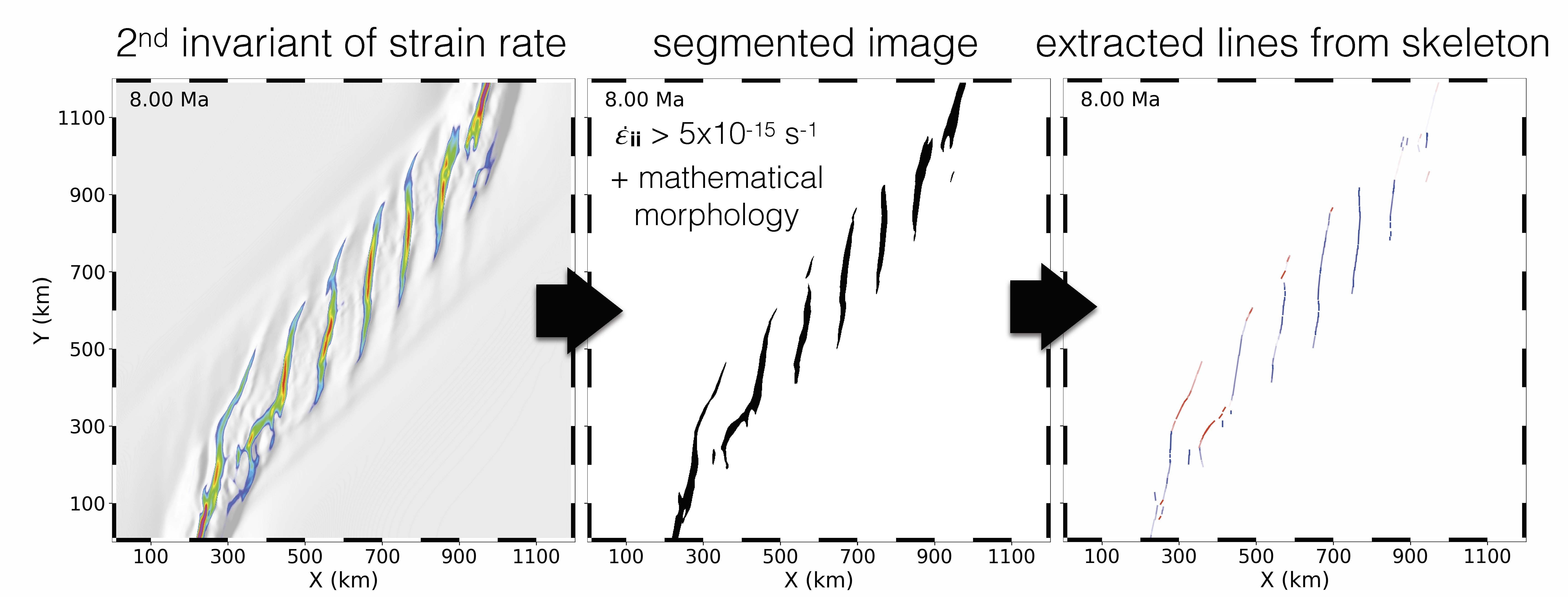
 |
| August 2020 Volume 9 Issue 3 |

Over the past three decades forward thermo-mechanical numerical modeling has transformed the way geoscientists look at the long-term evolution of the lithosphere. More than just generating aesthetically pleasing pictures, outputs from numerical models contain a rich source of quantitative information that can be used to infer the evolution of rocks in ancient and actively deforming regions. For example, pressure-temperature-time evolution of rock materials have long been extracted from 2D and 3D forward thermo-mechanical numerical models as these three scalar variables are direct outputs from the codes. Such data have been used successfully by petrologists and modelers to decipher the fate of metamorphic rocks in orogens providing valuable insights into the formation mobile belts. However, problem arises when one tries to extract structural patterns - which are not a scalar field computed in the codes - from 3D models. Structural data is the next step to adding value to any numerical experiment. How can we then compare, for example, the active surface deformation distribution in a 3D model with faults orientation in nature? It can be done manually by measuring active fault orientations at the surface of a model, but this is time consuming and might introduce bias in delineating individual faults. Some automatized attempts have relied on stress data, but as 3D strain dominates in 3D models, we cannot safely apply an Andersonian model to infer fault orientation ... continued
See the full article.
contributed by
Guillaume Duclaux, Université Côte d'Azur
Summer 2020 was unlike any of us could have ever imagined. Even before the resurgence of COVID-19 in the U.S., the pandemic laid bare the systemic inequities in many of our institutions. The growth of the anti-racist movement driven by the death of George Floyd, revealed the pervasiveness of this injustice. Proposed changes to student visa requirements would have harmed careers and the advancement of science in the U.S. In this time of uncertainty, we encourage our community to continue to support equity and science-based policy.
Through our networks, many of us are engaging in conversations on diversity, equity, and inclusion.1 Geosciences specifically is one of the least diverse sciences - geodynamics is no exception. At CIG, we have been successful in the inclusion of early career scientists and women in our outreach events and governance. For our ASPECT hackathon this year, 50% of our applicants and over half (54%) of our accepted participants self-identified as female. CIG’s Distinguished Speaker Programs for the last several years has sent dynamic young speakers, predominantly women, to institutions with large underserved communities in STEM. All Hosts this year are EPSCOR, HSIs, MSIs, and/or R2 institutions. I believe our continued strong support of women in leadership positions helps to create a welcoming environment for this group. However, there is still much work to be done in expanding this to underrepresented minorities.
A bright spot in this virtual new world is our ability to reach out to an increasingly diverse international community. Our July 2020 Tectonics Modeling (74 attendees) and Science Workshops (164 attendees) almost spanned the globe - GMT+12 to GMT-10, with significant participation from South America and participation from Africa, the Middle East, and Asia. I admire the dedication of researchers who attended during the very earliest of morning hours!
As we look towards CIG IV, I look forward to hearing your concerns and working with you in expanding the breadth of participation in our scientific community.
Lorraine Hwang, Director
1Keely O'Farrell has put together an excellent resource here for those looking for more information.
The Computational Infrastructure for Geodynamics (CIG) is looking for members of the community interested in stepping forward to provide the vision and leadership necessary for the next stage of CIG, CIG IV. It will be impossible to move forward without community participation and the vision of individuals willing to take on leadership roles. To achieve the best possible outcome, we are eager to listen and engage the community about new models for the structure and as well as new directions for CIG IV. Submittal deadline: August 17, 2020. For more information see the forum post.
Nominations are now open for this year's elections - 1 seat is open on the Executive Committee and 3 on the Science Steering Committee. Many thanks to EC member Carl Tape and SSC members David Ham, Jessica Irving, and Gabriele Morra for their contributions to the community. Email the Nominations Committee your nominations for these key governance positions as we plan the transition to CIG IV. A candidate can be placed on the slate by the Nominating Committee or by nomination by three Member Representatives. [email]
CIG seeks to encourage new ideas from the community by forming Focused Working Groups (FWG). FWG's should address a specific topic and have a clearly defined scope e.g. workshop, white paper, benchmark, etc. A FWG should define concrete outcome(s) achievable within a short time frame, < 2 years. Anyone can propose one! We look forward to your ideas in continuing the CIG community's dynamic leadership in the earth sciences. [email]
This virtual workshop will be held over 3 half-days from October 13 to 15 and aims to brings together the geophysics community to address the science that drives computational geophysics and the development of state-of-the-art software. Outcomes from this workshop will inform the development of the CIG IV proposal in 2021. Building the capacity for leadership level computation and promoting the use of cutting-edge algorithms throughout the CIG community demands a broad vision that includes community education, resource development, and increasing and supporting computational expertise to make computing more approachable and accessible. The workshop intends to provide a forum to discuss opportunities and initiatives to meet community needs in supporting the practice of leading-edge, open science.
As CIG looks towards the future, we invite community input on CIG initiatives through participation in discussions and contributions of science, technology, infrastructure, and outreach presentations. Participants from a wide range of disciplines in the computational and geosciences are encouraged to attend. We especially seek feedback from early-career scientists in creating the vision for the next phase of CIG to meet the future challenges in geodynamics. [info]
Information and reports on past workshops can be found on our website [past workshops]:
Remember to join our forum to receive announcements for these events.
| Fall 2020 |
Jonathan Perry-Houts, CIG UC Davis. |